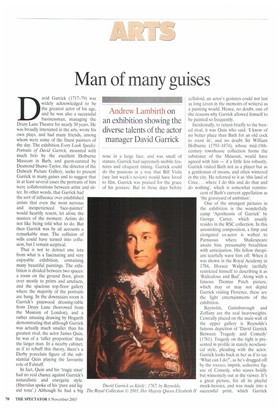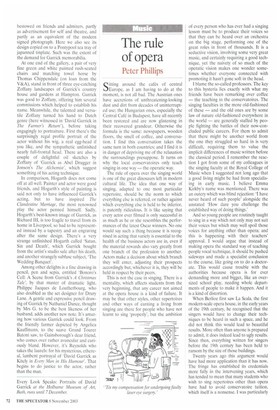Man of many guises
Andrew Lambirth on an exhibition showing the diverse talents of the actor manager David Garrick
David Garrick (1717-79) was widely acknowledged to be the greatest actor of his age, and he was also a successful businessman, managing the Drury Lane Theatre for nearly 30 years. He
was broadly interested in the arts, wrote his own plays, and had many friends, among whom were some of the finest painters of the day. The exhibition Every Look Speaks: Portraits of David Garrick, mounted with much brio by the excellent Holburne Museum in Bath, and guest-curated by Desmond Shawe-Taylor, the director of the Dulwich Picture Gallery, seeks to present Garrick in many guises and to suggest that in at least several cases the portraits of him were collaborations between artist and sitter. In other words, that Garrick had the sort of influence over established artists that even the most nervous and inexperienced lace-painter' would heartily resent, let alone the masters of the moment. Artists do not like being told what to do. But then Garrick was by all accounts a remarkable man. The collision of wills could have turned into collusion, but I remain sceptical.
That is not to detract one iota from what is a fascinating and very enjoyable exhibition, containing many beautiful paintings. The exhibition is divided between two spaces: a room on the ground floor, given over mostly to prints and artefacts, and the spacious top-floor gallery where the majority of the portraits are hung. In the downstairs room is Garrick's pinewood dressing-table from Drury Lane (borrowed from the Museum of London), and a rather amusing drawing by Hogarth demonstrating that although Garrick was actually much smaller than his greatest rival, the actor James Quin, he was of a 'taller proportion' than the larger man. In a nearby cabinet, as if to rebuff this theory, there's a Derby porcelain figure of the substantial Quin playing the favourite role of Falstaff.
In fact, Quin and his 'tragic strut' had no real chance against Garrick's naturalistic and energetic style. (Sheridan spoke of his 'pure and liquid tone'.) Although he had a big nose in a large face, and was small of stature, Garrick had supremely mobile features and eloquent timing. Garrick could do the passions in a way that Bill Viola (see last week's review) would have loved to film. Garrick was praised for the grace of his posture. But in those days before celluloid, an actor's gestures could not last as long (even in the memoirs of writers) as a painting would. Hence, no doubt, one of the reasons why Garrick allowed himself to be painted so frequently.
Incidentally, to return briefly to the bested rival, it was Quin who said: 'I know of no better place than Bath for an old cock to roost in', and no doubt Sir William Holburne (1793-1874), whose mid-19thcentury townhouse collection forms the substance of the Museum, would have agreed with him — if a little less robustly. Garrick visited Bath not as a player but as a gentleman of means, and often wintered in the city. He referred to it as 'this land of Circe. .. where I do this and do that and do nothing', which is somewhat reminiscent of Bath's current appellation as 'the graveyard of ambition'.
One of the strangest pictures in the exhibition is the wonderfully camp 'Apotheosis of Garrick' by George Carter, which usually resides in the RSC collection. In this astonishing composition, a limp and elongated ex-actor is wafted to Parnassus where Shakespeare awaits him, presumably breathless with anticipation. His fellow thespians tearfully wave him off. When it was shown in the Royal Academy in 1784, Horace Walpole tactfully restricted himself to describing it as 'Ridiculous and Bad'. Along with a fatuous Thomas Patch picture, which may or may not depict Garrick visiting Florence, these are the light entertainments of the exhibition.
Reynolds, Gainsborough and Zoffany are the real heavyweights. Centrally placed on the main wall of the upper gallery is Reynolds's famous depiction of 'David Garrick Between Tragedy and Comedy' (1761). Tragedy on the right is presented in profile in stately neoclassical style, pleading with the actor. Garrick looks back at her as if to say 'What can I do?', as he's dragged off by the rococo, impish, seductive figure of Comedy, who stares boldly but winsomely out at the viewer. It's a great picture, for all its playful mock-heroics, and was made into a successful print, which Garrick bestowed on friends and admirers, partly as advertisement for self and theatre, and partly as an equivalent of the modern signed photograph. Here we also see its design copied on to a Pontypool tea tray of japanned tinplate. Such was the extent of the demand for Garrick memorabilia.
At one end of the gallery, a pair of very fine green and white painted rush-seated chairs and matching towel horse by Thomas Chippendale (on loan from the V&A), stand in front of three eye-catching Zoffany landscapes of Garrick's country house and gardens at Hampton. Garrick was good to Zoffany, offering him several commissions which helped to establish his name. Meanwhile, the talented and versatile Zoffany turned his hand to Dutch genre (here witnessed in 'David Garrick in The Farmer's Return'), before taking engagingly to portraiture. First there's the surprisingly regal profile portrait of the actor without his wig, a real egg-head if you like, and the sympathetic unfinished nearly full-frontal head. There are also a couple of delightful oil sketches by Zoffany of 'Garrick as Abel Drugger in Janson's The Alchemist', which suggest something of his acting technique.
In comparison, Hogarth does not come off at all well. Painter and actor were good friends, and Hogarth's style of painting is said not only to have influenced Garrick's acting, but to have inspired The Clandestine Marriage, the most renowned play the actor penned himself. Sadly, Hogarth's best-known image of Garrick. as Richard III, is too fragile to travel from its home in Liverpool, so had to be represented instead by a tapestry and an engraving after the same design. There's a very strange unfinished Hogarth called 'Satan, Sin and Death', which Garrick bought from the artist's studio sale after his death, and another strangely subfuse subject, The Wedding Banquet'.
Among other delights is a fine drawing in pencil, pen and sepia, entitled 'Bonoro's Cell: A Scene from Garrick's A Christmas Tale', by that master of dramatic light, Philippe Jacques de Loutherbourg, who also doubled as the set designer for Drury Lane. A gentle and expressive pencil drawing of Garrick by Nathaniel Dance, thought by Mrs G. to be the best likeness of her husband, adds another new note. It's amazing how various Garrick could look. From the friendly farmer depicted by Angelica Kauffmann, to the suave Grand Tourer Batoni saw, to Gainsborough's dear friend, who comes over rather avuncular and curiously bland. However, it's Reynolds who takes the laurels: for his mysterious, ethereal, lambent portrayal of 'David Garrick as Kitely in Every Man in His Humour', That begins to do justice to the actor, rather than the man.
Every Look Speaks: Portraits of David Garrick at the Holburne Museum of Art, Bath, runs until 7 December.



































































































 Previous page
Previous page